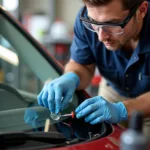Restoring your car door molding with a fresh coat of paint can significantly enhance your vehicle’s appearance. This guide will walk you through the steps of how to repair car door molding with paint, offering professional tips and techniques to achieve a flawless finish. From preparing the surface to applying the final coat, we’ll cover everything you need to know for a successful DIY repair.
Understanding Car Door Molding Damage
Before diving into the repair process, it’s crucial to understand the type of damage your car door molding has sustained. Is it chipped, scratched, faded, or cracked? Identifying the extent of the damage will help you determine the necessary repair approach and the right type of paint to use. Minor scratches and chips might only require touch-up paint, while more extensive damage might necessitate a complete repaint.
Gathering Your Materials for Car Door Molding Paint Repair
Having the right tools and materials is essential for a smooth and successful repair. You’ll need:
- Sandpaper (various grits)
- Primer
- Automotive paint (matched to your car’s color)
- Clear coat
- Masking tape and paper
- Cleaning solution (wax and grease remover)
- Microfiber cloths
- Paint applicators (brushes, spray cans, or a paint gun)
Preparing the Car Door Molding for Painting
Proper surface preparation is the key to a long-lasting and professional-looking paint job. Start by thoroughly cleaning the molding with a wax and grease remover to eliminate any contaminants that could interfere with paint adhesion. Next, sand the damaged area with progressively finer grits of sandpaper to smooth out any imperfections and create a suitable surface for the primer.
Priming the Car Door Molding
Once the surface is clean and sanded, apply a thin, even coat of primer. The primer acts as a bonding agent between the molding and the paint, ensuring better adhesion and color uniformity. Allow the primer to dry completely according to the manufacturer’s instructions.
Applying the Automotive Paint to the Molding
Now comes the exciting part – applying the paint! Whether you’re using a brush, spray can, or paint gun, apply thin, even coats to avoid runs and drips. Multiple thin coats are always better than one thick coat. Allow each coat to dry before applying the next.
Applying the Clear Coat for Protection
Once the final coat of paint is dry, apply a clear coat to protect the paint from UV rays, scratches, and other environmental factors. The clear coat also adds a glossy finish, enhancing the overall appearance of the repaired molding.
Finishing Touches and Reassembly
After the clear coat has dried, carefully remove the masking tape and paper. Inspect the repaired area for any imperfections and touch up if necessary. Once you’re satisfied with the results, reassemble any parts that were removed during the repair process.
How can I match the paint color to my car?
Most auto parts stores offer paint matching services. They can create a custom mix based on your car’s paint code, ensuring a perfect match.
What type of paint should I use for car door molding?
Automotive acrylic lacquer or urethane paints are recommended for durability and color retention.
Can I repair cracked car door molding with paint?
While paint can improve the appearance of cracked molding, it won’t fix the underlying structural damage. For severe cracks, replacement is often the best option.
“A properly prepared surface is 80% of a successful paint job,” says renowned auto body specialist, John Miller. “Take your time with the prep work, and the results will speak for themselves.”
Conclusion
Repairing car door molding with paint is a cost-effective way to restore your car’s appearance and protect it from further damage. By following these steps and using the right materials, you can achieve professional-looking results right in your own driveway. Remember, patience and attention to detail are key to a successful repair. So, gather your supplies, follow our guide on how to repair car door molding with paint, and enjoy the satisfaction of a job well done!
FAQ
- How long does the paint take to dry completely? Drying times vary depending on the type of paint and environmental conditions, but generally, it takes 24-48 hours for complete curing.
- Can I use regular spray paint on car door molding? It’s not recommended. Automotive paint is specifically formulated to withstand the harsh conditions of the road and provide better durability and color retention.
- How can I prevent future damage to my car door molding? Regular cleaning, waxing, and parking carefully can help protect your molding from scratches and chips.
- What if the damage is too extensive for a DIY repair? Consult a professional auto body shop for more complex repairs or replacements.
- Do I need to remove the car door molding before painting? While not always necessary, removing the molding can make the painting process easier and provide a more even finish.
Common Scenarios and Questions:
- Scenario: Deep scratches that expose the underlying material. Solution: Fill the scratches with automotive filler before sanding and painting.
- Question: Can I paint over existing paint on the molding? Answer: Yes, as long as the existing paint is in good condition and properly prepared.
Explore More Car Repair Tips
For more helpful car repair advice, check out our articles on:
- How to repair car scratches
- How to fix a dented car bumper
- DIY car maintenance tips
Need assistance? Contact us via WhatsApp: +1(641)206-8880, Email: [email protected]. We have a 24/7 customer support team.


